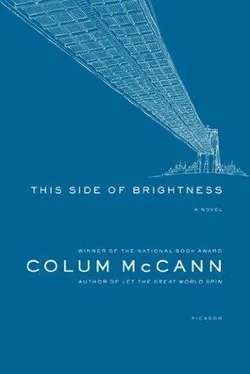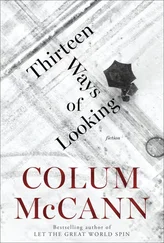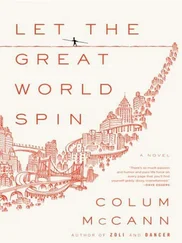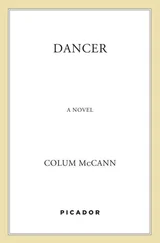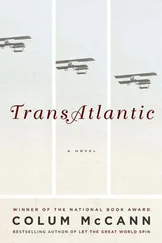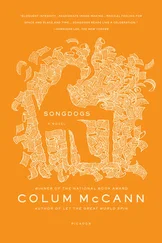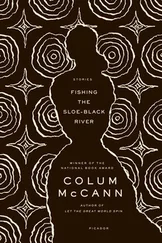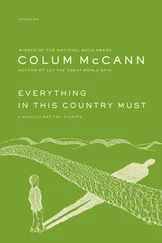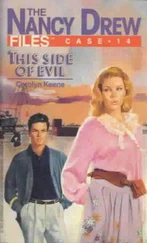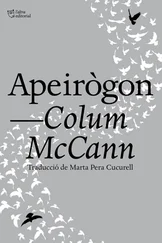He hears a couple of rodents scuttle in the rear cave. “Fuck,” he says, “fuck.” He throws an empty can over his shoulder. It rattles against the wall of the cave and the rats are quiet for a moment; then they begin scrabbling once more. Time to set some traps.
Sitting up in his sleeping bag, Treefrog puts his hands down by his crotch for warmth, leans forward, and looks across the low wall of his elevated home.
The first snow falls through the ceiling of the tunnel, filtering down through the metal grill. Forty feet in the air, the grill holds the snow for a moment and then releases it. The flakes spin in shafts of light, blue winter light. They gyrate and land by the railway tracks, forming patches of snow that reach out into the tunnel, and are then swallowed by darkness. Treefrog has seen this happen often enough that he has learned not to be surprised, but still he watches for a long while and then he says aloud to nobody, “Underground snow.”
* * *
Each day begins like any other. His morning ritual. He rises and dresses in the abysmal cold, lights a candle, closes his eyes. He moves, blind, to the rear of his nest. The nest is two rooms in all: an old elevated storage room and a cave.
Treefrog feels the darkness, smells it, belongs to it.
In the cave he crouches and moves around with his eyes shut. Candle wax drips onto his hand. The cave is black and damp. Nooks and crannies in the rumples of gray rock. A ledge on the wall. Hidden cubbyholes big enough to stuff his fist into. He places the candle on top of the ledge and reaches for a piece of graph paper and a sharpened pencil. Circling the small cave, he trails his hand against the wall as he goes, feeling the crevices and coldness. With each change in the landscape he opens his eyes and marks an increment on the graph paper. He returns and feels the same place with his other hand, caresses the rock, and lets the cold seep through his leather gloves. He breathes heavily and imagines the clouds his breath makes before his eyes — strange shapes and odd motions. Running his hands along the wall, he instinctively bends and twists and turns and comes to his library, tucked at the very back of the cave. Both his palms rest on a rickety wooden shelf, and he stays there as if in prayer.
Treefrog switches the pencil from hand to hand.
On the shelf he keeps his engineering journals, encased in special plastic bags, labeled with stickers. He runs his fingers along them, stopping at his favorite — tunnel building — and then moves on past his collection of maps, down the length of the world and beyond.
Ducking out from the cave, he goes back to the large front chamber; even with his eyes closed, he knows the shadows that appear in the flickering candlelight. His boots slide from carpet to dirt floor back to carpet again. He never places a foot wrong and always takes an even number of paces. Every hollow and crinkle of mud is recognized from the way it touches his feet. Most of his junk is kept here, old crates, newspapers, a sofa found bloated in the rain, cans, pots, knives, needles, three dozen hubcaps, and books stuffed into Ziploc bags to protect them from the damp. Kindling is piled around the fire pit. Treefrog stops at the Gulag, a foot-deep hole in the wall. Beneath the Gulag is a box for his cat, Castor, to sleep in. Nudging along the wall, under a clothesline strung together from ties, past his bed, Treefrog is careful not to let his feet touch the giant piss bottles lined up at the end of the mattress.
He will empty the bottles later, taking them topside to carve his name yellow in the snow where it will be illegible except to the crows.
At the edge of his nest he reaches up and touches a steel girder, spins his body, and reaches out his other hand. He marks the high edge of the graph paper with his pencil. Treefrog feels for a broken speedometer hung from the steel girder of his nest — the needle stuck at thirty-six, his age — and he says to himself, Take it easy, don’t crash.
He opens his eyes, looks at the graph paper, the rows of dots and the squiggled lines. He draws a quick ordnance survey profile of where he has walked. This is his most important ritual; he cannot start his day without it. He exaggerates the features to ten times their map size, so that, on the paper, the nest looks like a rumple of huge valleys and mountains and plains. Even the tiniest nicks in the wall become craters. Later he will transfer them to a larger map he has been working on for the past four years, a map of where he lives, hand-drawn, intricate, secretive, with hills, rivers, ox-bow lakes, curved creeks, shadows: the cartography of darkness.
Fingers trembling in the cold, Treefrog stuffs the morning’s map into his bedside table drawer and walks onto the catwalk with his eyelids shut. The narrow beam requires supreme balance — below him is a twenty-foot drop to the tunnel. He swings his way down to the second beam ten feet below, crouches, then leaps and drops soundlessly to the gravel, knees bent, heart thumping. He opens his eyes to the darkness.
* * *
He lives three blocks from anybody else in the tunnel. Sometimes, gazing along its length, he sees a watery movement in the distance, and it looks to Treefrog like a canoe being paddled with intent; or his daughter swimming toward him, arms stretched wide; or his wife moving through the blackness, slender, night-eyed, forgiving. But then the dark clarifies itself, and the visions are gone.
* * *
Sitting in the stream of blue light from topside — beside the mural of Salvador Dalí’s Melting Clock — Treefrog lets the flakes fall down around him. From his overcoat pocket he takes a hypodermic needle, holding it to his eyes to see the marked calibrations. He fills the syringe quarter full with air, then wets the size sixteen needle with his tongue. Almost icy enough for his tongue to freeze against the metal. He leaves a bubble of spittle on the point and rummages in his other pocket for a pink handball. He shoves the needle into the ball and pushes the end of the plastic casing. It feels like entering skin. The ball bloats with air and Treefrog rubs the new roundness of it. Perfect. He takes a black pen and marks the point where the needle entered the ball, searches in the depths of his overcoat for a second syringe, already filled with glue. The syringe is wrapped in a sock to keep it warm. He strokes the casing with both hands.
Treefrog plunges the second needle into the mark on the pink ball and lets out a slow whistle as the glue pumps into the rubber. It will take half an hour to harden, but the air and glue will give the ball a greater bounce. Further down the tunnel he hears a grunt, and he turns but sees nobody.
“Heyyo,” he says to the darkness. “Heyyo.”
Taking a second handball from his pocket, he steps back toward the tracks and faces the Melting Clock. The mural was drawn years ago by Papa Love, long before Treefrog came to the tunnel. The clock — gray and black, eight feet high, drawn under the grill to catch the light — is curved like a woman’s waist. Beside it, the wall has been slashed with a drunken line of red graffiti. Gangs of kids came down in the summer with spray cans. Treefrog watched them from his nest. Their baseball hats were turned backward. They stuck close together and were scared. After spraying the walls they left empty cans along the edge of the tunnel. But they never touched Papa Love’s murals. They even knocked on the door of the old man’s shack, but Papa Love never answered his door: never has, never will.
In the cyclorama of snow, Treefrog throws the ball against the wall, his black hair and long beard swinging around him. He slaps the ball first with his right hand, then with his left, there are laws to this game: he must maintain the balance of his body, keep the equilibrium, never hit out of sequence. If he hits twice with the left hand he must hit twice with the right. When he slams with the center of the right palm he must slam with the center of the left. He concentrates on the pink ball bouncing back from the mural. Most of all he likes it when he hits the heart of the Melting Clock, where the mural wiggles near clockhand four.
Читать дальше
